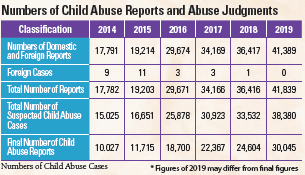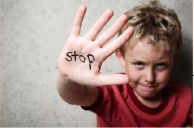On September 14th, boys who stayed home due to the coronavirus disease 2019 (COVID-19) were injured in a fire while trying to prepare a meal. It was soon revealed that the mother who was not at home when the incident occurred was under indictment on charges of violating the Child Welfare Act unveiling the circumstances of neglect that boys were subject to. Even though their neighbors notified the police three times, they were unable to provide practical help due to parental rights. Similarly, numerous children are placed in the blind spots of child abuse protection. Child abuse leaves permanent physical and mental pain, and victims need practical help. To commemorate the World Day for the Prevention of Child Abuse on November 19th, the Sungkyun Times (SKT) would like to uncover the current status and problems of child abuse and introduce how to prevent and deal with it.
Introduction of Child Abuse
The Concept of Child Abuse
According to Article 3 Clause 7 of the Child Welfare Act, child abuse refers to the act of an adult, including guardians, hindering a child’s welfare and mental development through physical, mental, sexual abuse, or abandoning his or her child. This demonstrates that both excessive discipline and education with physical punishment could be seen as child abuse. As shown in Article 17 of the Child Welfare Act, child abuse is categorized into physical, emotional, sexual, and neglect abuse. To be specific, neglect abuse is “the act of ignoring a child’s necessities including protection, nurture, and treatment of illnesses” and is classified into physical, educational, medical, and abandonment. According to the annual report of child abuse in 2019 by the Ministry of Health and Welfare (MOHW), the number of concurring abuse cases reached 14,476, followed by physical, emotional, sexual, and neglect abuse.
The number of child abuse reports in 2019 increased by 13.7% (41,389 cases) compared to 2018. The graph below shows a steady increase in child abuse cases from 2014, and a large percentage was caused by people who live with and are closely related to children. 76% of abusers were parents, followed by surrogate caregivers, relatives, and more. Cases frequently occurred at home and childcare organizations such as schools and daycare centers. They are abused by the people that are responsible for protecting them. Child abuse violates children’s basic rights, threatens lives, and causes unnecessary suffering.

Child Abuse, Ruining Children’s Futures
Children should live in safe environments, but child abuse ruins this by leaving lasting consequences and can continue when passed down, which in turn, can generate more victims. First of all, the psychological damage is difficult to identify, but the victim can experience difficulty controlling his or her emotions and expressing socially appropriate behavior. Dr. Oh Eun-young, a child psychiatrist, states that children abused by the same people who gave them life would feel that everyone in the world is untrustworthy. Thus, children will undergo harsh circumstances throughout their lives and experience difficulty adapting to school life and maintaining personal relations. Furthermore, according to the Korean Institute for Health and Social Affairs (KIHASA), the trauma from the abuse may lead children to become cold-hearted or struggle with excessive obsessions due to their lack of trust in people. Also, there is a high possibility that the abuse will be further passed down to the next generation due to mental aftereffects. A report from the KIHASA shows that 44.8% of abusers were abused during their childhood. These consequences infer that the children’s misfortune may be transmitted to the next generation, resulting in other victims. Therefore, the seriousness of child abuse must be acknowledged, and practical solutions need to be devised.
Serious Reasons for Child Abuse in Korea
The Principle of Original Household Protection
Because perpetrators are typically people with parental rights or legal liability over the victims, it is difficult to fundamentally solve the problem. On January 10th, news outlets reported a sad story of a nine-year-old child left alone in cold water wearing only underwear, which led to his death. His parents had him endure the cold water because he ran noisily inside the house. Previous reports of the abuse in 2016 had the child separated from his parents twice. His father visited the protection agency in February of 2018, promising to take good care of him at home. The agency sent the child home, and eventually met with the bad news. Child protection agencies are forced to send children back home because of The Principle of Original Household Protection of the Child Welfare Act. The Principle of Original Household Protection states that the government and agencies should support the return of children to their original households unless the parents are deprived of their parental rights. However, only 25 perpetrators of 19,214 total cases of child abuse had parental rights taken away. Moreover, child protection agencies can continue monitoring abuse victims via follow-up visits unless the parents refuse. Due to these reasons, the number of children exposed to re-abuse continues to increase.

Lack of Protection Agency and Experts
Victims of child abuse could truly recover and adapt to society once protection agencies and child development experts are fully endorsed. The lack of support causes abused children to receive insufficient protection and education. To be specific, although many protection agencies in Korea were built before the 1970s, they still maintain communal living which leads to deficient management of children. Also, the lack of experts and their administrative authority is not of practical help to the victims. According to the National Child Protection Agency (NCPA)’s survey of social workers working at protection agencies, each expert is responsible for about 64 cases, which is two to three times more than the standards suggested by the MOHW (32 cases) and Good Neighbors International (20 cases). Additionally, these experts are not given administrative authority. When experts contact victims’ families for post-management, they are often criticized for intervening in their families’ problems. Since most of the child protection agencies in Korea are commissioned civilian institutions under the MOHW, the experts possess a civilian status without public authority to post manage victims. The most important factor that decides the quality of protection agencies is the expertise of professional agencies. Thus, when excellent experts provide high-quality protection, the lives of children will be guaranteed.
Efforts to Protect “Our Futures”
Change in the Law
In Korean Constitution, children are not considered as independent people, but people under their parents’ protection. According to Article 31-2 of the Constitution, all parents are obliged to provide at least primary education to “their children” under their protection. “Their children” in this clause means that children are tied to their parents and that they are seen only as objects of duty, not as a being with their rights. In contrast, Clause 1 of Article 11 of the Constitution in Switzerland states, “Children and adolescents have the right to be supported for full protection and growth development.” Likewise, Korean laws should recognize children’s rights and the protection together provide in the Constitution, which is the basis of all laws as in the case of Switzerland. Through this change in the constitution, children should be perceived as humans with rights like adults in society. Moreover, as mentioned earlier, the focus of the Child Welfare Act is to prioritize children’s ties with their original household quickly. This act will eliminate the opportunity to protect children from domestic abuse that may happen again. Amendments to change the act must be introduced. When agencies get a report, agencies must limit parent’s parental rights and hand children over to protection agencies. After completing the necessary education and reviewing parent’s qualifications to take their children back, the agencies send the children back to their parents. Also, the child’s input must be considered during the process.

Management of Protection Services and Teachers
Improving the management of protection facilities, as well as the expansion, management, and support of professionals in protective facilities, are all fundamental solutions to the problem. Furthermore, we should know that there is a significant lack of treatment and education for teachers in domestic protection agencies. According to the research on the Status and Improvement of Infant Abuse Perception in Families and Institutions of the Child Care Policy Institute (CDPI) in 2016, all teachers in Germany should be guided by a lawyer on child protection for six months before they become teachers, and receive specific job training on child protection for 14 weeks while working. Teachers in Korea, however, attend a mandatory hour-long session about the prevention of child abuse. After they become teachers, the heads of each facility are required to annually educate teachers for only an hour. This is significantly insufficient when compared to other countries. Also, The Child Abuse Punishment Law states that employees of facilities related to children can be punished by a sentence increase of up to 50% in the cases of child abuse, such as assault or injury. This law, however, only focuses on post punishment rather than the prevention of child abuse. Proper education, as well as improved treatment for teachers, is necessary to protect the children who will shape Korea’s future.
To turn a blind eye will ruin not only our children but also the future of society. As the number of child abuse cases increases, efforts are being made both nationally and personally. Despite the increasing re-abuse rate, however, practical help is still not being provided to the victims because of society’s misjudgment, lack of protection facilities, and inefficient legislations. Therefore, child abuse should be recognized not only as a problem of the victims and offenders but something that society must work together to preven To turn a blind eye will ruin not only our children but also the future of society. As the number of child abuse cases increases, efforts are being made both nationally and personally. Despite the increasing re-abuse rate, however, practical help is still not being provided to the victims because of society’s misjudgment, lack of protection facilities, and inefficient legislations. Therefore, child abuse should be recognized not only as a problem of the victims and offenders but something that society must work together to prevent.
